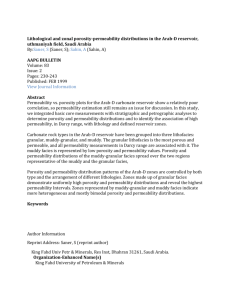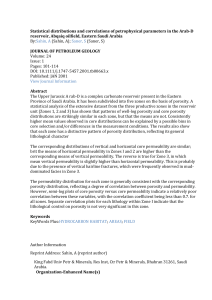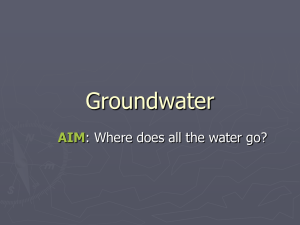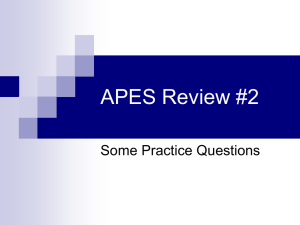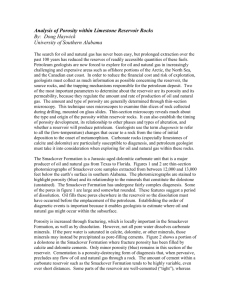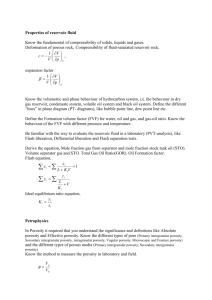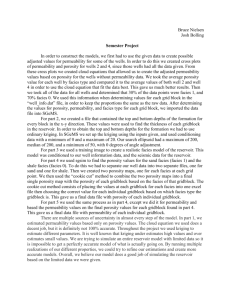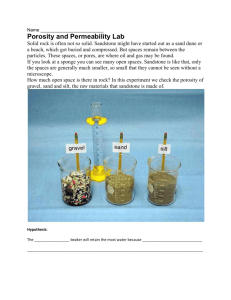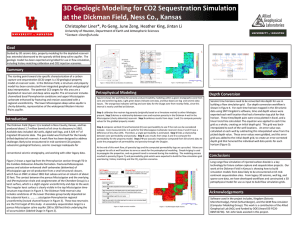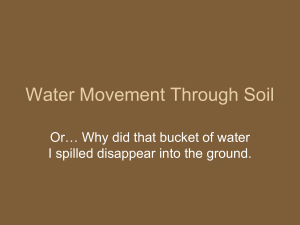Uncertainty in petroleum reservoirs
advertisement
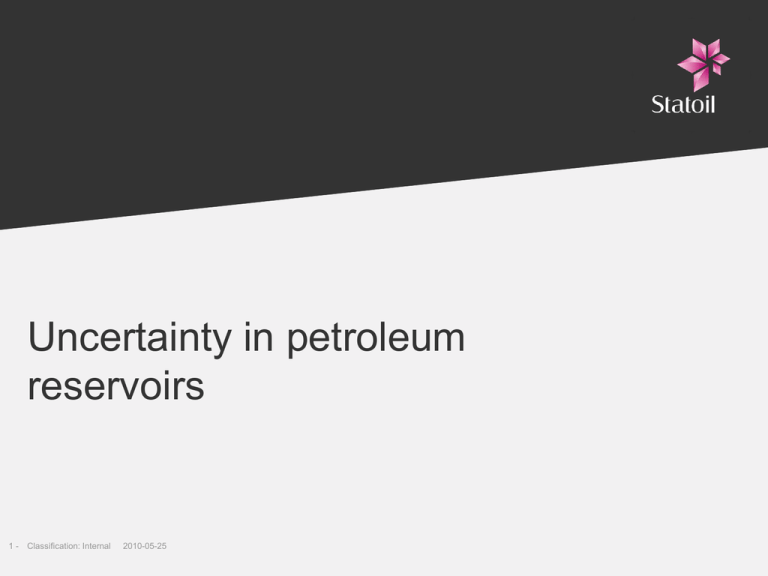
Uncertainty in petroleum
reservoirs
1 - Classification: Internal
2010-05-25
Finding the reservoir I
2 - Classification: Internal
2010-05-25
Finding the reservoir II
The underground is packed with density gradients:
Top and base of
reservoir (I think …).
Interpreting this is a far cry from hard science.
3 - Classification: Internal
2010-05-25
Geological properties
4 - Classification: Internal
2010-05-25
Exploration well – try to infer properties
on km scale from point measurement.
Porosity and permeability
High porosity
High permeability
5 - Classification: Internal
2010-05-25
Low porosity
Low permeability
OK – what is inside this reservoir
Internal barriers?
Interface depth?
6 - Classification: Internal
2010-05-25
Fluid properties
Water-wet reservoir
7 - Classification: Internal
2010-05-25
Oil-wet reservoir
Uncertain factors
– The geometry of the reservoir – including internal compartmentalization.
– The spatial distribution of porosity and permeability.
– Depth of fluid interfaces.
– Fluid and fluid-reservoir properties.
–…
8 - Classification: Internal
2010-05-25
What to do with it?
1. Deterministic models: Attempts at modelling and quantifying uncertainty are
certainly done, but this is mainly in the form of variable (stocastic) input, not
stocastic dynamics.
2. Before production: A range input values is tried out, and the future production is
simulated.These simulations are an important basis for investment decisions.
3. After production start: When the field is producing we have measured values of
e.g. produced rates of oil, gas and water which can be compared with the
simulated predictions → a misfit can be evaluated, and the models updated.
9 - Classification: Internal
2010-05-25
History matching (or revisionism)
1. Select a set ”true” observations you
want to reproduce in your simulations.
2. Select a (limited) set of parameters to
update.
3. Update your parameters as best you
can.
4. Simulate your model and compare
simulated results with observations.
5. Discrepancy below tolerance?
Yes
6. You have an updated model.
10 - Classification: Internal
2010-05-25
No
History matching – it is just plain stupid
Traditionally History Matching is percieved as an optimization problem – a very
problematic approach:
–The problem is highly nonlinear, and severely underdetermined.
–The observations we are comparing with can be highly uncertain.
–The choice of parameterization is somewhat arbitrary – we will optimize in the
wrong space anyway.
11 - Classification: Internal
2010-05-25
A probabilistic problem – Bayesian setting.
{m} : Model parameters
{d} : Observed data
Likelihood
Prior
P({d } | {m}) P({m})
P({m} | {d })
P({d })
Posterior
12 - Classification: Internal
2010-05-25
The objective function
Guassian likelihood:
Covariance of measurement errors.
P(d|m) = exp(-(S(m) – d)TC-1(S(m) – d))
Result from the simulator
Observed data
Evaluation of S(m) requires running the simulator and is very costly.
13 - Classification: Internal
2010-05-25
How to find the posterior??
EnKF: Data assimilation technique based on ”resampling” of finite ensemble in a
Gaussian approximation. Gives good results when the Gaussian approximation
applies, and fails spectactularly when it does not apply.
BASRA (McMC with proxy functions): Flexible and fully general approach.
”Guaranteed” to converge to the correct posterior, but the convergence rate can be
slow.
14 - Classification: Internal
2010-05-25
Kalman filter
Kalman filter: Technique for sequential state estimation based on combining
measurements and a linear equation of motion. Very simple example:
Forecast
State estimate:
Updated
XA
F
C
X F F xx
dXF
Cxx Cdd
Measurement
(Co)variance
estimate:
Forecast
error
Measurement
F error
C
15 - Classification: Internal
2010-05-25
A
xx
C xx
1 F
C xx Cdd
F
C xx
EnKF
When the equation of motion is nonlinear predicting the state covariance becomes
difficult. The EnKF approach is to let an ensemble (i.e. sample) evolve with the
equation of motion, and use the sample covariance as a plugin estimator for the
state covariance.
–Gaussian likelihood.
Computationally efficient – but limiting
–Gaussian prior
–A combined parameter and state estimation problem.
–The updated state is linear combination of the prior states.
16 - Classification: Internal
2010-05-25
EnKF - linear combination
Permeability
Permeability
Permeability
Permeability
Porosity
Porosity
Porosity
Porosity
Porosity
Relperm
Relperm
Relperm
Relperm
Relperm
MULTFLT
MULTFLT
MULTFLT
MULTFLT
MULTFLT
Integrate
EnKF update: AA = AFX
Observation
17 - Classification: Internal
2010-05-25
Time
Permeability
EnKF update: sequential
The EnKF method updates the models every time data is available.
Last historical data
WOPR
Future prediction
• When new data becomes available we can continue without ”going back”.
TIME
18 - Classification: Internal
2010-05-25
BASRA Workflow
1. Select a limited ( <~ 50 ) parameters {m} to
update, with an accompanying prior.
2. Perturb the parameter set {m} → {m} + δ{m}
and evaluate a new misfit O’({m}).
3. Accept the new state with probability
P = min{1,exp(-δO({m})}.
4. When this has converged we have one
realization {m} from the posterior which can
be used for uncertainty studies; repeat to get
an ensemble of realizations.
19 - Classification: Internal
2010-05-25
The evaluation of the misfit is
prohibitively expensive, and
advanced proxy modelling is
essential.
BASRA Results
Converging the proxies:
Marginal posteriors:
Prior
Posterior ensemble:
Posterior
20 - Classification: Internal
2010-05-25
Current trends
– Reservoir modelling usually involves a chain of weakly coupled models and
applications – strive hard to update parameters early in the chain.
– Update of slightly more exotic variables like surface shapes and the direction of
channels.
– The choice of parameterization is somewhat arbitrary – we will optimize in the
wrong space anyway. A more systematic approach to choosing parameterization
would be very valuable.
21 - Classification: Internal
2010-05-25
